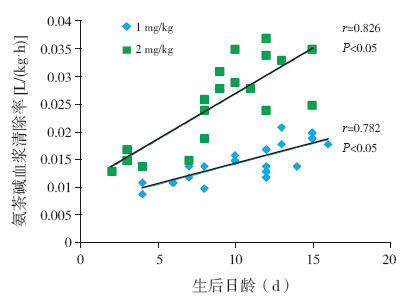 PDF(1254 KB)
PDF(1254 KB)


Investigation of pharmacokinetics and pharmacodynamics of different doses of aminophylline in very low birth weight infants
YANG Xiao-Yan, ZHAO Jing, SHI Jing, WU Jin-Lin, CHEN Da-Peng, TANG Jun, XIONG Ying, MU De-Zhi
Chinese Journal of Contemporary Pediatrics ›› 2015, Vol. 17 ›› Issue (11) : 1171-1175.
 PDF(1254 KB)
PDF(1254 KB)
 PDF(1254 KB)
PDF(1254 KB)
Investigation of pharmacokinetics and pharmacodynamics of different doses of aminophylline in very low birth weight infants
Objective To study the pharmacokinetic and pharmacodynamic features of different doses of aminophylline in very low birth weight (VLBW) infants with different postmenstrual ages, weights, and ages (in days). Methods A total of 40 VLBW infants with apnea were enrolled. After an intravenous loading dose of 5 mg/kg aminophylline, they were randomized into two groups with different maintenance doses of aminophylline (1 mg/kg and 2 mg/kg, once every 8 hours). Blood concentrations of aminophylline and liver and renal functions were monitored at 8 hours, 3 days, and 7 days after the loading dose. Attacks of apnea were documented. Pharmacokinetic data of aminophylline were compared between the two groups. Results The steady-state plasma concentration of aminophylline and plasma clearance in the 2 mg/kg group were significantly higher than those in the 1 mg/kg group (P<0.05). However, the elimination half life was shorter in the 2 mg/kg group (P<0.05). Days of apnea attacks within 7 days after birth in the 2 mg/kg group were significantly fewer than in the 1 mg/kg group (P<0.05). Aminophylline plasma clearance was positively correlated with age (in days) after birth and postmenstrual age in both groups. Conclusions In VLBW infants, pharmacokinetics and pharmacodynamics are different when different maintenance doses of aminophylline are given. The maintenance dose of 2 mg/kg is associated with a better effect in the treatment of apnea. Postmenstrual age and age (in days) should be considered during the adjustment of dose, and routine blood concentration monitoring should be performed.

Aminophylline / Pharmacokinetics / Pharmacodynamics / Maintenance dose / Very low birth weight infant